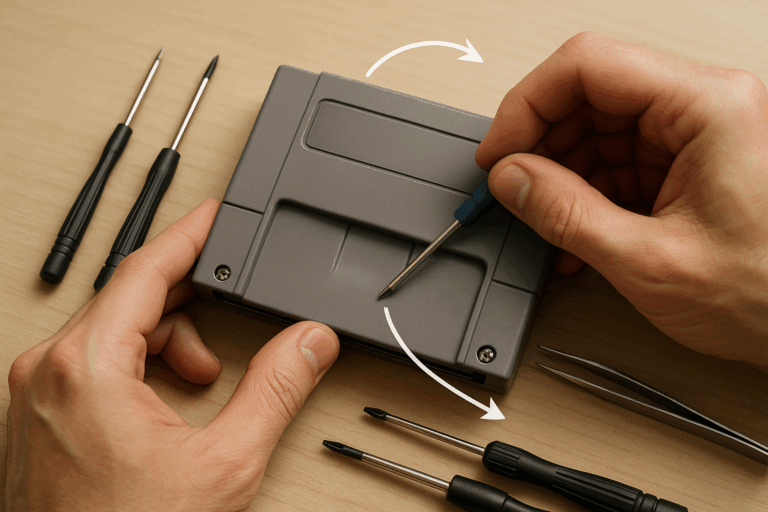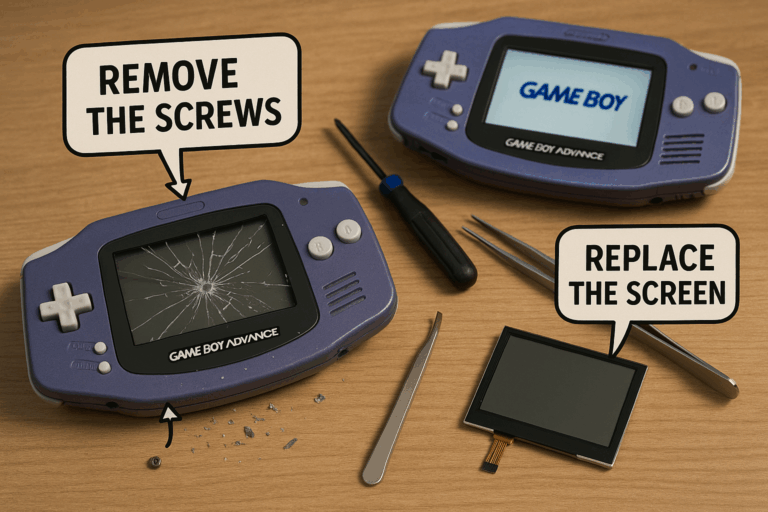As the hands of time relentlessly march forward, the relics of technological advancements past often find themselves gathering dust in forgotten corners of closets and garages. Nostalgic pieces of tech like the Atari 2600, Commodore 64, and even the beloved Nintendo Entertainment System can frequently be relegated to these dimly lit recesses, their lustrous appeal dimmed by the passing years. But fear not, fellow tech enthusiasts, for there is a silver lining. The digital revolution has not only brought us cutting-edge gadgets and software, but it also provides us with the means to breathe new life into these time-honored pieces of technological artistry. Welcome, reader, to an exploration of “Revive the Past: How to Build Your Own Retro Repair Workshop and Bring Vintage Tech Back to Life from the Comfort of Home”.
Throughout this article, we’ll be delving into the intricacies of creating your very own sanctuary of restoration – a retro repair workshop. From the importance of space allocation, to the nitty-gritty of sourcing obsolete components, this article will serve as a comprehensive guide, leading you through the labyrinth of challenges associated with such a venture. We’ll draw upon industry best practices and personal experiences, merging the theoretical and the practical in a symphony of information designed to equip you with the necessary knowledge to undertake this thrilling journey back in time.
Yet, this is not merely a technical manual, but a call to arms for those with a shared love for retro tech. It’s a celebration of the formative years of technological development, a reverie of the pure joy found in the tactile response of a mechanical keyboard or the whir of a cassette tape rewinding. It’s an invitation to join a community of like-minded individuals, those who perceive the potential for resurrection within every dust-coated vintage tech. With each restored piece, we’re not just reviving a piece of hardware – we’re keeping alive a piece of history, a tangible testament to the leaps and bounds of human ingenuity.
So, whether you’re an experienced tinkerer with a penchant for all things vintage, or a curious newbie intrigued by the charm of the technological yesteryears, this article promises a plethora of insights. Prepare to be immersed in a world where technology meets history, where the worn-out can be revitalized, and where the old becomes new again. Together, let’s roll up our sleeves, dust off that forgotten tech, and embark on a journey to restore the past, one piece at a time. Welcome to the exciting world of retro tech repair, a world where the past meets the future, and where every restoration is a nostalgic trip down memory lane.
## Introduction
Welcome to the world of retro tech, where nostalgia and innovation collide. Whether you’re an old-school tech enthusiast, an amateur tinkerer, or a professional engineer, creating your own retro repair workshop can be a satisfying and rewarding experience. This guide will walk you through everything you need to know about setting up your home workshop, sourcing vintage tech, and getting started with repairs.
## H2: Setting Up Your Retro Repair Workshop
Creating a functional and efficient workspace is the first step in building your retro repair workshop. Here, you’ll need to consider factors such as space, lighting, tools, and safety.
### H3: Space and Organization
When designing your workshop, keep in mind that you’ll need enough space to store your tools and parts, as well as a large enough work surface to handle the tech you’ll be repairing. Also, consider how you’ll organize your tools and components – a well-organized workspace can significantly increase efficiency and reduce frustration.
In the video “Workshop Organization Ideas and Tips” from the channel “DIY Creators” (click here to watch), you can find many practical suggestions for setting up your workspace.
### H3: Lighting and Tools
Good lighting is crucial in a repair workshop. Ideally, you’ll want a combination of overhead lighting and task lighting to illuminate your work surface. In terms of tools, start with the basics – screwdrivers, pliers, multimeters, and soldering equipment – and gradually add specialized tools as needed.
### H3: Safety
Lastly, don’t overlook safety. Make sure you have a fire extinguisher, first aid kit, and personal protective equipment such as goggles and gloves. If you’re going to be soldering, ensure you have proper ventilation to avoid inhaling fumes.
## H2: Sourcing Vintage Tech
Finding and acquiring vintage tech can be a fun and rewarding aspect of setting up your retro repair workshop. Whether you’re interested in old computers, gaming consoles, radios, or other vintage devices, there are several places to look.
### H3: Online Auction Sites and Marketplaces
Online platforms like eBay and Craigslist can be gold mines for vintage tech. Here, you can often find a wide range of items, from fully functioning devices to ‘for parts’ listings. Be sure to check the description and images carefully, and don’t hesitate to ask the seller questions if you’re unsure about an item’s condition.
### H3: Flea Markets and Garage Sales
Flea markets, garage sales, and thrift stores are also great places to find vintage tech. While it might take a bit more time and patience, you can often find unique items at bargain prices. Plus, it’s a chance to meet like-minded collectors and enthusiasts.
### H3: Online Communities and Forums
Joining online communities such as Reddit’s r/vintagecomputing or forums like Vintage Computer Federation can be a great way to connect with other enthusiasts, get advice, and find leads on items for sale or trade.
## H2: Learning to Repair Vintage Tech
Now that you’ve set up your workspace and sourced some vintage tech, it’s time to roll up your sleeves and get to work. If you’re new to electronics repair, start small and gradually take on more complex projects as you gain confidence and skills.
### H3: Online Tutorials and Resources
There are countless online resources to help you learn about vintage tech repair. Websites like iFixit offer detailed guides and tutorials on a wide range of devices. You can also find many YouTube channels dedicated to vintage tech repair, such as “Adrian’s Digital Basement” (click here to watch).
### H3: Books and Manuals
In addition to online resources, consider picking up some books on electronics repair. Many vintage tech items also have service manuals available, which can be invaluable resources for understanding how a device works and troubleshooting issues.
### H3: Practice, Practice, Practice
The best way to learn is by doing. Start with simple repairs and gradually take on more complex projects as you gain confidence. Remember, it’s OK to make mistakes – that’s part of the learning process.
| Resource | Description |
|---|---|
| iFixit | An online community for people who repair things. Offers detailed repair guides for a wide range of devices. |
| Adrian’s Digital Basement (YouTube) | A YouTube channel dedicated to vintage tech repair. Offers tutorials, tips, and teardown videos. |
| Vintage Computer Federation | A forum for vintage computer enthusiasts. Offers advice, community, and marketplace. |
In summary, building your own retro repair workshop can be a rewarding journey that combines nostalgia, problem-solving, and hands-on work. So why wait? Roll up your sleeves, dust off that old tech, and bring it back to life!

Conclusion
Having traversed the exciting and engaging journey of setting up a retro repair workshop, we have explored a world where nostalgia meets innovation, and old-school technology finds new life. In this remarkable expedition, we have uncovered the essentials of designing a functional workspace, delved into sourcing vintage tech and finally, unraveled the process of learning to repair these technological treasures.
Initiating the workshop setup process, we stressed the importance of adequate space and organization, and explored Workshop Organization Ideas and Tips to make the process more efficient. We highlighted the need for proper lighting and basic tools and underscored the importance of safety measures, reminding our readers that a secure workspace is a productive workspace.
We then ventured into the exciting endeavor of sourcing vintage tech. We discussed the opportunities offered by online auction sites, marketplaces, and physical spaces like flea markets, garage sales, and thrift stores. Further, we emphasized the value of online communities and forums, such as Reddit’s r/vintagecomputing and Vintage Computer Federation, as great platforms to connect, share, and learn.
Delving into the realm of repairing vintage tech, we accentuated the wealth of resources available to learn from. Websites like iFixit provide comprehensive guides, and YouTube channels like “Adrian’s Digital Basement” offer practical demonstrations. We recommended books, manuals, and most importantly, emphasized that practice is the key to mastering this craft.
In essence, creating a retro repair workshop is more than just a hobby; it’s an opportunity to bring back to life pieces of technology that once shaped the world. As we embark on this rewarding journey, we not only get to engage our problem-solving skills and express our creativity but also contribute to a sustainable future by giving a second life to technology.
We invite you to embrace this enriching journey, dive into the world of vintage tech, and experience the thrill of restoring and reviving these retro gems. So, pull up your sleeves, rekindle your passion for retro tech, and transform your workspace into a haven for these cherished devices.
We hope this guide has inspired you to embark on your journey into the world of retro tech repair. If you have any questions, insights, or experiences to share, we encourage you to comment below. Your feedback and participation enrich our collective learning experience. Don’t hesitate to share this article with others who might also find this interesting and helpful.
And remember, the journey of a thousand miles begins with a single step. So, why wait? Take the leap and start building your retro tech repair workshop today!
Click here to visit the Vintage Computer Federation forum and connect with other vintage tech enthusiasts. For practical, hands-on guides, check out iFixit and the Adrian’s Digital Basement YouTube channel. Happy repairing!



